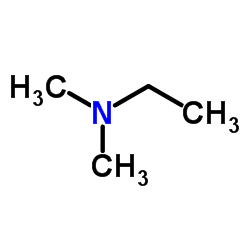DMEA

DMEA structure
|
Common Name | DMEA | ||
|---|---|---|---|---|
| CAS Number | 598-56-1 | Molecular Weight | 73.137 | |
| Density | 0.7±0.1 g/cm3 | Boiling Point | 36.3±3.0 °C at 760 mmHg | |
| Molecular Formula | C4H11N | Melting Point | −140 °C(lit.) | |
| MSDS | Chinese USA | Flash Point | -36.1±0.0 °C | |
| Symbol |



GHS02, GHS05, GHS07 |
Signal Word | Danger | |
|
Acute toxicity and primary irritancy of alkylalkanolamines.
Vet. Hum. Toxicol. 38(6) , 422-6, (1996) The acute handling hazards of several alkylalkanolamines were determined by investigating their potential acute toxicity and primary irritancy. Materials studied were N-methylethanolamine (MEA), N, N, -dimethylethanolamine (DMEA), N, N, -dimethylisopropanolam... |
|
|
Ammonia as a preferred additive in chiral and achiral applications of supercritical fluid chromatography for small, drug-like molecules.
J. Chromatogr. A. 1220 , 147-55, (2012) Supercritical fluid chromatography is routinely utilized by analytical separations groups in the pharmaceutical industry to efficiently handle separations for discovery medicinal chemistry purposes. Purifications are performed on samples ranging from a few mi... |
|
|
The many roles for fluorine in medicinal chemistry.
J. Med. Chem. 51 , 4359-69, (2008)
|
|
|
Human trace amine-associated receptor TAAR5 can be activated by trimethylamine.
PLoS ONE 8(2) , e54950, (2013) In addition to the canonical olfactory receptors, TAARs were currently suggested to be a second class of chemosensory receptors in the olfactory epithelium of vertebrates. In contrast to several deorphanized murine TAARs, agonists for the intact human TAAR ge... |
|
|
Liquid membrane work-up of blood plasma samples applied to gas chromatographic determination of aliphatic amines.
J. Chromatogr. A. 573(2) , 191-200, (1992) A technique for sample work-up and enrichment using a supported liquid membrane in an automated flow system, connected to a gas chromatograph, was used for the determination of aliphatic amines in human blood plasma. The amines studied were N,N-dimethylethyla... |
|
|
An industrial hygiene appraisal of triethylamine and dimethylethylamine exposure limits in the foundry industry.
Am. Ind. Hyg. Assoc. J. 49(12) , 630-4, (1988) For nearly two decades, triethylamine and dimethylethylamine have been used as catalysts for phenolic urethane cold box binders in the foundry industry. During that time there have been reports of employees experiencing visual disturbances as a result of expo... |
|
|
1,2-Eliminations from (CH3)2NH+CH2CH3 and (CH3)2NH2+: guided dissociations.
J. Am. Soc. Mass Spectrom. 19(10) , 1491-9, (2008) 1,2-Eliminations are a varied and extensive set of dissociations of ions in the gas phase. To understand better such dissociations, elimination of CH(2)=CH(2) and CH(3)CH(3) from (CH(3))(2)NH(+)CH(2)CH(3) (1) and of CH(4) from (CH(3))(2)NH(2)(+) are character... |
|
|
Self-reinforced endocytoses of smart polypeptide nanogels for "on-demand" drug delivery.
J. Control. Release 172(2) , 444-55, (2013) The pH and reduction dual-responsive polypeptide nanogels with self-reinforced endocytoses were prepared through ring-opening polymerization of l-glutamate N-carboxyanhydrides, deprotection of benzyl group and subsequent quaternization reaction between _-2-ch... |
|
|
Phosphatidylethanolamine and sarcolemmal damage during ischemia or metabolic inhibition of heart myocytes.
Am. J. Physiol. 268(2 Pt 2) , H773-80, (1995) Phosphatidylethanolamine (PE) is a nonbilayer-preferring and fusogenic phospholipid. It is kept in the bilayer configuration by interaction with other phospholipids in biologic membranes. However, reorganization of the membrane phospholipids could lead to exp... |
|
|
Dimethylethylamine in mould core manufacturing: exposure, metabolism, and biological monitoring.
Br. J. Ind. Med. 48(3) , 203-7, (1991) The exposure and metabolism of dimethylethylamine (DMEA) was studied in 12 mould core makers in four different foundries using the Ashland cold box technique. The mean time weighted average (TWA) full work shift DMEA exposure concentration was 3.7 mg/m3. Inha... |